
Aviation Partners Inc. (API) is a Seattle-based private corporation that specializes in performance-enhancing winglet systems. The corporation was founded in 1991 and is owned by The Washington Companies.

Aviation Partners Inc. (API) is a Seattle-based private corporation that specializes in performance-enhancing winglet systems. The corporation was founded in 1991 and is owned by The Washington Companies.
API was founded in 1991 by Joe Clark and Dennis Washington, bringing together a team consisting primarily of retired Boeing and Lockheed engineers and flight test department directors. His design team was led by Dr. Louis "Bernie" Gratzer, who retired from Boeing that same year (after a distinguished career which included the aerodynamic design of the KC-135, 707 and 727) and immediately began with API, with title of senior vice president. [1]
Washington, a US entrepreneur who made his money from copper mining, was frustrated that his private jet could not fly coast-to-coast in the US without refueling. Instead of buying a new aircraft, he approached his friend Joe Clark who had experience in the aviation industry having co-founded Horizon Air. Clark calculated that by increasing the wings' performance, non-stop coast-to-coast flying would be possible. [2] Together with a group of aviation specialists, Clark developed a new winglet, and with permission from Gulfstream, fitted the winglet to Washington's jet. Test flights confirmed a fuel saving and range increase of 4–5%. [2] Washington and Clark then set out on a publicity campaign to sell the idea. They started setting a number of World Records in performance with the winglets. [2]
In 1997, API's winglets were sold as a standard fit on all Boeing Business Jets, and winglets were offered as an addition to standard 737s. Around 95% of all 737 customers want winglets fitted. [2]
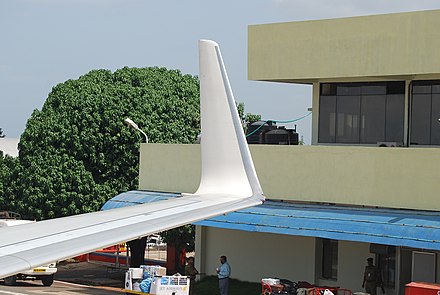
Aviation Partners formed a joint venture with Boeing, called Aviation Partners Boeing (APB), in 1997. This entity licenses the Blended Winglet Technology for use on Boeing aircraft. [3] Starting with the Boeing Business Jet, winglets have been factory installed onto the Boeing 737 Next Generation as well as retrofitted on 737 'Classic' (Boeing 737-300 and -500) and 757 and 767-300ER airliners. [4]
In addition to the Boeing airliner programs, API has certified winglets for the Hawker 800 series jets and has over 100 Blended Winglet equipped Hawkers in service as of December 2008.
At EBACE 2007, Dassault Aviation, in conjunction with Aviation Partners, announced the Falcon 2000 LX aircraft. A derivative of the Falcon 2000 EX airframe, it is the first aircraft to be put into production with API's new High Mach winglets. The Falcon 2000-winglets received FAA certification on April 16, 2009 with the 900 series receiving certification in September 2011. Dassault and API also are developing winglets for the Falcon 50 series aircraft.
Airbus worked with Aviation Partners from 2006 through 2011, in an effort to modernize its A320 family of jets. In 2011, however, Airbus announced that it came up with its own design, which it branded "sharklets," and obtained a patent in Europe. In December 2011, Airbus filed suit in Texas seeking to invalidate Aviation Partners' 1994 winglet patent. [5] Airbus settled the lawsuit by making a large payment to Aviation Partners in 2018. [6]
By 2009, API's product had been introduced to the Boeing 757, Boeing 767, several Business Jets. [2]
Aviation Partners is currently developing the Spiroid winglet, a closed wing surface mounted at the end of a conventional wing. Initial testing using a Gulfstream II test aircraft has shown the winglet design to reduce fuel consumption in the cruise phase by over 10%. [7]
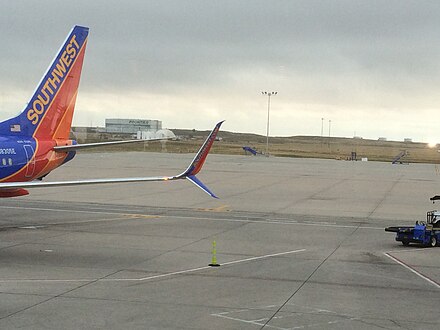
APB's Split Scimitar Winglet retrofit program consists of retrofitting 737NG's winglets by replacing the aluminum winglet tip cap with a new aerodynamically shaped "Scimitar" winglet tip cap and by adding a new Scimitar tipped ventral strake. This modification demonstrated approximately 2% drag reduction over the basic Blended Winglet configuration. [8] FAA granted supplemental type certification (STC) for the Split Scimitar Winglet (SSW) retrofit on the 737-800 and BBJ2 on February 6, 2014, for 737-900ER on August 27th, 2014, for 3 additional 737-800 wing configuration on October 2, 2014, and for all models of the 737-700 including the Boeing Business Jet on April 21, 2015. [9]
APB expects Scimitar Winglet Systems installed on a 737-800 to save the typical airline more than 45,000 gallons of jet fuel per aircraft per year resulting in a corresponding reduction of carbon dioxide emissions of 476 tons per aircraft per year. The fuel savings can enable a 737-800 to increase its payload up to 2,500 pounds or increase its range up to 75 nautical miles. APB also expects to certify an improvement in low speed performance that will generate significant take-off benefits from high/hot or obstacle limited runways. [10] The first European Split Scimitar Winglets were installed on the TUI fleet aircraft in Stansted in 2014 by Chevron Technical Services Ltd.
APB sign deal in October 2015 with Japan Transocean Air, Siam Air, Myanmar National Airlines, Solaseed Air and Lion Air to install Split Scimitar Winglets starting 2016. They will be the only Asian Split Scimitar Winglets user that has been confirmed. [10]

The Boeing 767 is a wide-body airliner developed and manufactured by Boeing Commercial Airplanes. The airliner was launched as the 7X7 project on July 14, 1978, the prototype first flew on September 26, 1981, and it was certified on July 30, 1982. The original 767-200 entered service on September 8 with United Airlines, and the extended-range 767-200ER in 1984. It was stretched into the 767-300 in October 1986, followed by the 767-300ER in 1988, the most popular variant. The 767-300F, a production freighter version, debuted in October 1995. It was stretched again into the 767-400ER from September 2000.
United Airlines, Inc. is a major American airline headquartered at Willis Tower in Chicago, Illinois. United operates a large domestic and international route network spanning cities large and small across the United States and all six continents. Measured by fleet size and number of routes, it is the third largest airline in the world. It is a founding member of the Star Alliance, the world's largest airline alliance with a total of 28 member airlines. Regional service is operated by independent carriers under the brand name United Express. United was established by the amalgamation of several airlines in the late 1920s, the oldest of these being Varney Air Lines, which was founded in 1926.

The Boeing 737 is a narrow-body aircraft produced by Boeing Commercial Airplanes at its Renton Factory in Washington. Developed to supplement the 727 on short and thin routes, the twinjet retains the 707 fuselage cross-section and nose with two underwing turbofans. Envisioned in 1964, the initial 737-100 made its first flight in April 1967 and entered service in February 1968 with Lufthansa. The lengthened 737-200 entered service in April 1968. It evolved through four generations, offering several variants for 85 to 215 passengers.

The Boeing 757 is an American narrow-body airliner that was designed and built by Boeing Commercial Airplanes. The then-named 7N7, a successor for the 727, received its first orders in August 1978. The prototype completed its maiden flight on February 19, 1982 and it was FAA certified on December 21, 1982. Eastern Air Lines placed the original 757-200 in commercial service on January 1, 1983. A package freighter (PF) variant entered service in September 1987 and a combi model in September 1988. The stretched 757-300 was launched in September 1996 and began service in March 1999. After 1,050 had been built for 54 customers, production ended in October 2004, while Boeing offered the largest 737 NG variants as a successor.
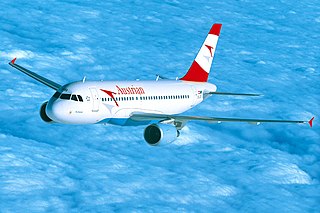
The Airbus A319 is a member of the Airbus A320 family of short- to medium-range, narrow-body, commercial passenger twin-engine jet airliners manufactured by Airbus. The A319 carries 124 to 156 passengers and has a maximum range of 3,700 nmi. Final assembly of the aircraft takes place in Hamburg, Germany and Tianjin, China.

The Airbus A320 family are narrow-body airliners designed and produced by Airbus. The A320 was launched in March 1984, first flew on 22 February 1987, and was introduced in April 1988 by Air France. The first member of the family was followed by the longer A321, the shorter A319, and the even shorter A318 . Final assembly takes place in Toulouse in France; Hamburg in Germany; Tianjin in China since 2009; and in Mobile, Alabama in the United States since April 2016.

The Airbus A321 is a member of the Airbus A320 family of short to medium range, narrow-body, commercial passenger twin engine jet airliners and carries 185 to 236 passengers. It has a stretched fuselage which was the first derivative of the baseline A320 and entered service in 1994 about six years after the original A320. The aircraft shares a common type rating with all other Airbus A320-family variants, allowing previous A320-family pilots to fly the aircraft without the need for further training.
Compañía Panameña de Aviación, S.A., is the flag carrier of Panama. It is headquartered in Panama City, Panama, with its main hub at Tocumen International Airport. Copa is a subsidiary of Copa Holdings, S.A. as well as a member of Star Alliance. The airline is also the main operator and owner of Colombian airline AeroRepública, currently known as Copa Airlines Colombia.
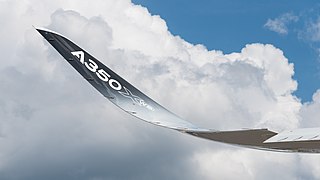
Wingtip devices are intended to improve the efficiency of fixed-wing aircraft by reducing drag. Although there are several types of wing tip devices which function in different manners, their intended effect is always to reduce an aircraft's drag by partial recovery of the tip vortex energy. Wingtip devices can also improve aircraft handling characteristics and enhance safety for following aircraft. Such devices increase the effective aspect ratio of a wing without greatly increasing the wingspan. Extending the span would lower lift-induced drag, but would increase parasitic drag and would require boosting the strength and weight of the wing. At some point, there is no net benefit from further increased span. There may also be operational considerations that limit the allowable wingspan.

The Boeing Business Jet series are variants of Boeing jet airliners for the corporate jet market.

Boeing Commercial Airplanes (BCA) is a division of the Boeing Company. It designs, assembles, markets, and sells jet airliners and business jets ; it also provides product-related maintenance and training to customers worldwide. It operates from division headquarters in Renton, Washington, with more than a dozen engineering, manufacturing, and assembly facilities located throughout the U.S. and internationally. BCA includes the assets of the Douglas Aircraft division of the former McDonnell Douglas Corporation, which merged with Boeing in 1997. In late 2016, BCA was home to some 78,000 employees.

A trijet is a jet aircraft powered by three jet engines. In general, passenger airline trijets are considered to be second-generation jet airliners, due to their innovative engine locations, in addition to the advancement of turbofan technology.
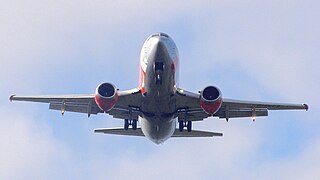
A twinjet or twin-engine jet is a jet aircraft powered by two engines. A twinjet is able to fly well enough to land with a single working engine, making it safer than a single-engine aircraft in the event of failure of an engine. Fuel efficiency of a twinjet is better than that of aircraft with more engines. These considerations have led to the widespread use of aircraft of all types with twin engines, including airliners, fixed-wing military aircraft, and others.

Comlux is an aviation company based in Switzerland, headquartered in Zürich. It provides services in fields of aircraft operations and charter management, aircraft sales and acquisitions, maintenance and upgrades.

The competition between Airbus and Boeing has been characterised as a duopoly in the large jet airliner market since the 1990s. This resulted from a series of mergers within the global aerospace industry, with Airbus beginning as a European consortium while the American Boeing absorbed its former arch-rival, McDonnell Douglas, in 1997. Other manufacturers, such as Lockheed Martin and Convair in the United States, and British Aerospace and Fokker in Europe, were no longer able to compete and effectively withdrew from this market.

The Boeing 737 Next Generation, commonly abbreviated as 737NG, or 737 Next Gen jet airplanes are narrow-body aircraft powered by two engines and produced by Boeing Commercial Airplanes. Launched in 1993 as the third generation derivative of the Boeing 737, it has been produced since 1997 and is an upgrade of the 737 Classic (−300/-400/-500) series.
James David Raisbeck is a notable American aeronautical engineer, known for his entrepreneurship in developing products which enhance the performance of production aircraft.
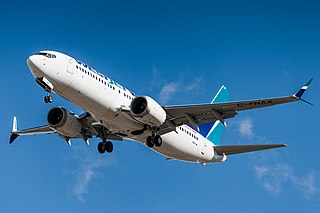
The Boeing 737 MAX is the fourth generation of the Boeing 737, a narrow-body airliner manufactured by Boeing Commercial Airplanes (BCA). It succeeds the Boeing 737 Next Generation (NG). It is based on earlier 737 designs, re-engined with more efficient CFM International LEAP-1B engines, aerodynamic changes, which include its distinctive split-tip winglets, and airframe modifications.

Fuel economy in aircraft is a measure of how much fuel an aircraft, or a fleet of aircraft of mixed types, needs to operate in relation to a service provided and the distance between points of travel. It can be expressed in several ways, for example by the liters of fuel consumed per passenger per kilometer.
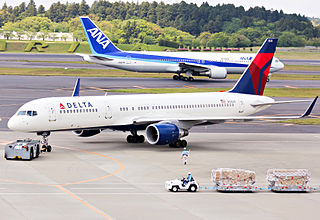
The New Midsize Airplane (NMA), or New Midsize Aircraft, is a concept airliner designed by Boeing to fill the middle of the market segment.